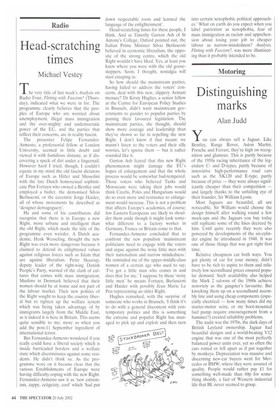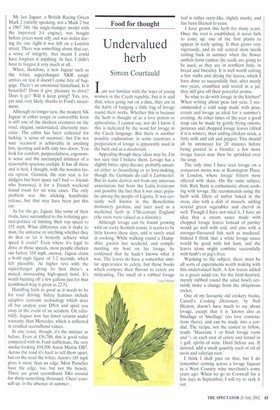Distinguishing marks
Alan Judd
You can always sell a Jaguar. Like Bentley, Range Rover, Aston Martin, Porsche and Ferrari, they're high on recognition and glamour. This is partly because of the 1950s racing inheritance of the legendary Cand D-types, partly because of innovative high-performance road cars such as the XK120 and E-type, partly because of price — they were always significantly cheaper than their competition — and largely thanks to the unfailing eye of their founder, Sir William Lyons.
Most Jaguars are beautiful, all are noticeable. Sir William would choose the design himself after walking round a few mock-ups and the Jaguars you buy today still replicate some of the lines decreed by him. Until quite recently they were also powered by developments of the six-cylinder engine he introduced in 1948. It was one of those things that was got right first time.
Relative cheapness cut both ways. You got plenty of car for your money, didn't have to be rich to aspire to them and relatively low secondhand prices ensured popular demand. Such availability also helped the Mark 2 saloons of the 1960s achieve notoriety as the gangster's favourite. But knocking them up on a secondhand assembly line and using cheap components (especially electrical — how many times did my starter-motor seize, or my boot-mounted fuel pump require encouragement from a hammer?) created reliability problems.
The nadir was the 1970s, the dark days of British Leyland ownership. Jaguar had beautiful designs and a world-beating V12 engine that was one of the most perfectly balanced power units ever, yet so often the cars rotted or fell apart as if put together by monkeys. Depreciation was massive and discerning new-car buyers went for Mercedes or BMW, where they were assured of quality. People would rather pay £1 for something well-made than 60p for something shoddy, a fact of Western industrial life that BL never seemed to grasp.
My last Jaguar, a British Racing Green Mark 2 (strictly speaking, not a Mark 2 but a 1967 340, the single-bumper model with the improved 3.4 engine), was bought before prices went silly and was stolen during the one night it was left on a London street. There was something about that car, a sense of integrity, that meant I could have forgiven it anything. In fact, I didn't have to forgive it very much at all.
When, therefore, a new Jaguar such as the 4-litre supercharged )(KR coupe arrives on test it doesn't come free of baggage. There's an emotional hinterland. Is it beautiful? Does it give pleasure to drive? Does it go? Will it keep going? Yes, yes, yes and, very likely, thanks to Ford's investment.
Although no longer new, the modern XK Jaguar in either coupe or convertible form is still one of the sleekest creatures on the road, elegant, understated, discreetly muscular. The cabin has been criticised for lacking 'a sense of occasion', but I'm not sure 'occasion' is achievable in anything low, sporting and with only two doors. You look for comfort, purposefulness, ergonomic sense and the uncramped intimacy of a reasonably spacious cockpit. It has all these and is best. I thought, with the wooden fascia option. Granted, the rear seat is for midgets but boot space isn't bad — friends who borrowed it for a French weekend found room for six wine cases. The only problem was the sticking handbrake release, but that may have been just this car.
As for the go, Jaguar, like some of their rivals, have succumbed to the irritating gesture-politics of limiting their top speed to 155 mph. What difference can it make to man, the universe or anything whether they do that or let it honestly achieve what speed it could? Even where it's legal to drive at those speeds, most people chicken out before 150 mph, anyway. Jaguar claim a 0-60 mph figure of 5.2 seconds, which felt plausible. At higher revs with the supercharger giving its best there's a muted, intoxicating high-speed howl. It's worth burning off a few gallons just for that (combined mpg is given as 22.5).
Handling feels as good as it needs to be for road driving. Safety features include adaptive restraint technology which does all but analyse your DNA and spirit you away in the event of an accident. On reliability. Jaguar now has fewer returns under warranty than Mercedes, which is reflected in residual secondhand values.
In one sense, though, it's the mixture as before. Even at £56,700. this is good value compared with its Ford stablemate, the very similar-looking £94,500 Aston Martin DB7. Across the road it's hard to tell them apart, but on the road the 6-litre Aston's 185 mph gives it more than an edge. Most Porsches have the edge, too, but not the beauty. There are good secondhand XKs around for thirty-something thousand. Cheer yourself up, in the absence of summer.



























































 Previous page
Previous page